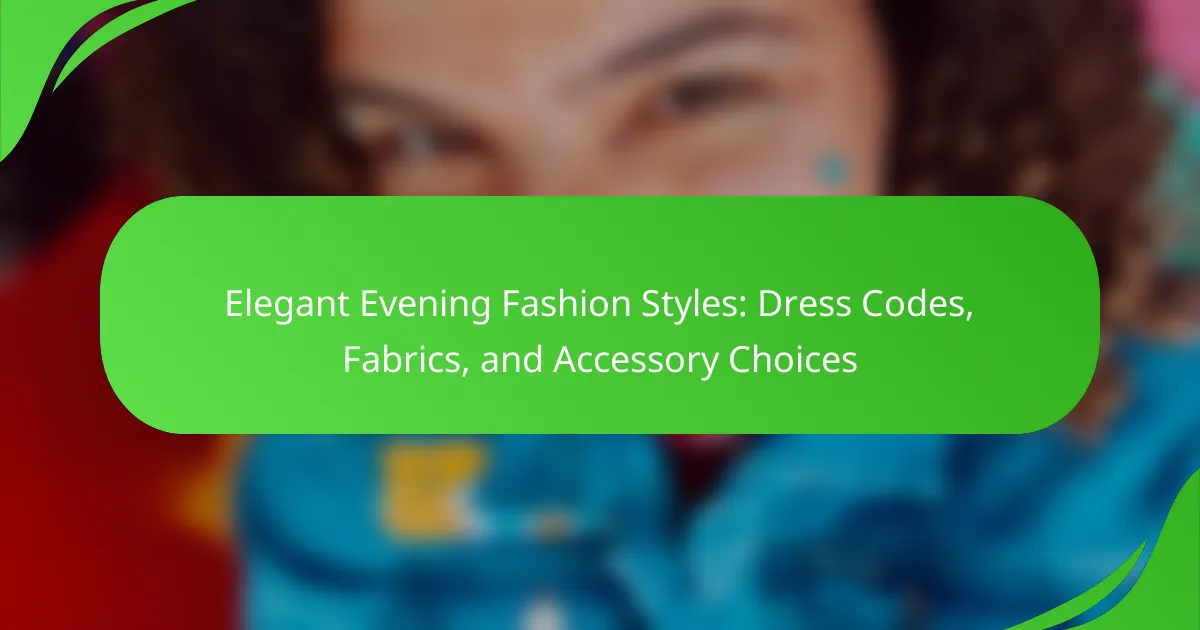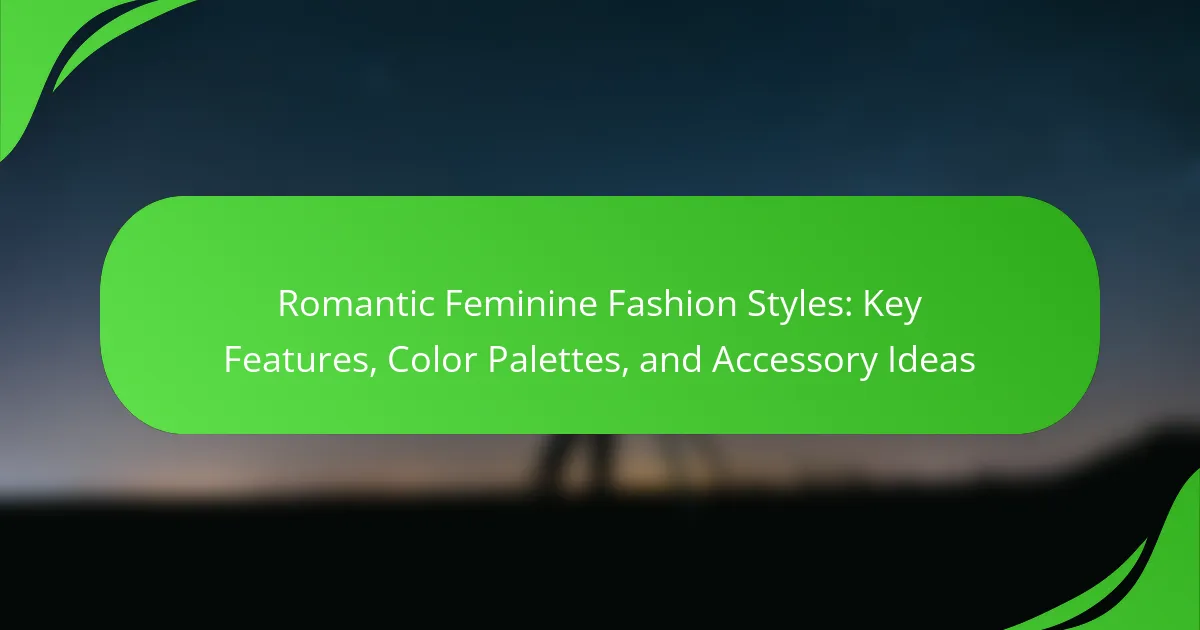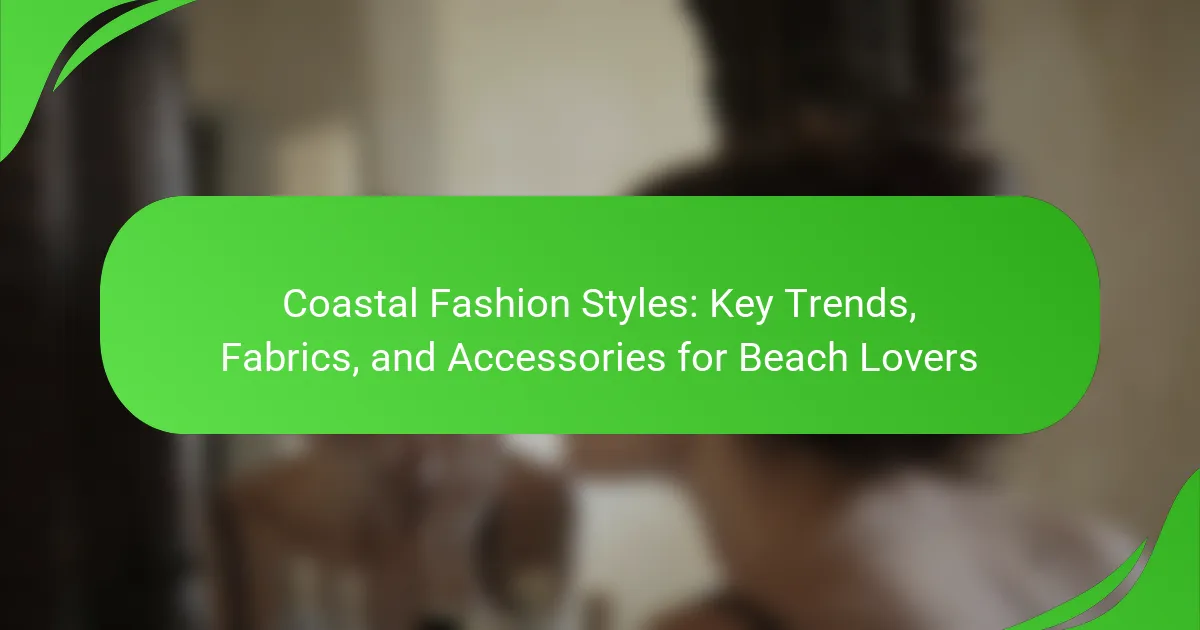Elegant evening fashion styles encompass sophisticated attire designed for formal events, including long evening gowns, tailored tuxedos, and cocktail dresses. Commonly used fabrics such as silk, satin, and chiffon enhance the luxurious appearance of these outfits, which often feature rich colors and intricate embellishments. Understanding dress codes—formal, semi-formal, or cocktail—is essential for selecting appropriate attire, while accessories like statement jewelry and elegant clutches play a crucial role in complementing the overall look. Key elements to consider include fabric choice, color selection, and proper fit, all of which contribute to a polished and refined appearance suitable for occasions like galas and formal dinners.
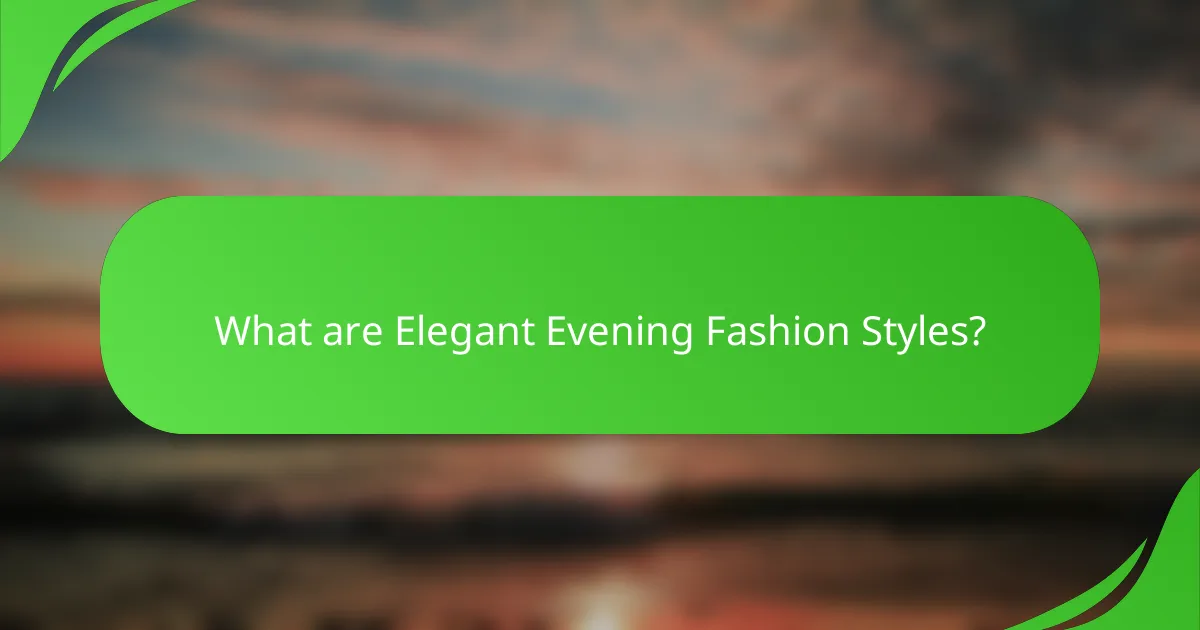
What are Elegant Evening Fashion Styles?
Elegant evening fashion styles refer to sophisticated attire designed for formal events. These styles typically include long evening gowns, tailored tuxedos, and cocktail dresses. Fabrics such as silk, satin, and chiffon are commonly used for their luxurious appearance. Elegant evening fashion often features rich colors and intricate embellishments. Accessories like statement jewelry, elegant clutches, and stylish heels complement the outfits. This fashion style aims to create a polished and refined look suitable for occasions like galas and formal dinners.
How do dress codes influence elegant evening fashion styles?
Dress codes significantly influence elegant evening fashion styles by dictating appropriate attire for specific events. Formal dress codes typically require evening gowns or tuxedos, guiding individuals toward sophisticated fabric choices like silk or satin. Semi-formal codes allow for cocktail dresses and tailored suits, promoting a balance between elegance and comfort. Casual dress codes, while more relaxed, still encourage polished looks, often incorporating smart casual attire. Historical context shows that dress codes have evolved, reflecting societal norms and expectations. For example, the introduction of the “black tie” dress code in the early 20th century established a standard for evening elegance that persists today. Overall, dress codes serve as a framework, shaping choices in color, style, and accessories for evening events.
What are the different types of dress codes for evening events?
The different types of dress codes for evening events include formal, semi-formal, cocktail, and casual. Formal dress code typically requires evening gowns for women and tuxedos for men. Semi-formal allows for shorter dresses and suits, offering more flexibility. Cocktail attire suggests stylish dresses and dressy separates. Casual dress codes permit comfortable yet polished outfits. Each dress code serves a specific purpose and reflects the event’s formality level. Understanding these distinctions helps attendees dress appropriately for various occasions.
How can one determine the appropriate dress code for an occasion?
To determine the appropriate dress code for an occasion, one should first consider the event type. Different events have specific expectations for attire. For example, weddings often require formal or semi-formal wear. Corporate events may call for business casual or formal attire.
Next, check the invitation for dress code details. Invitations often specify terms like “black tie,” “cocktail,” or “casual.” Researching these terms helps clarify expectations. Consulting with the host can also provide insight into the desired dress code.
Additionally, consider the venue and time of day. Evening events typically lean towards more formal attire. Outdoor events may allow for more casual clothing.
Finally, observe cultural norms and local customs. These factors can influence appropriate attire. Adhering to these guidelines ensures one is dressed suitably for the occasion.
What fabrics are commonly used in elegant evening fashion?
Silk, satin, chiffon, and velvet are commonly used fabrics in elegant evening fashion. Silk is known for its luxurious feel and natural sheen. Satin offers a smooth surface and drapes beautifully. Chiffon is lightweight and creates an ethereal look. Velvet has a rich texture and adds depth to designs. These fabrics are favored for their elegance and ability to enhance the overall aesthetic of evening wear.
Which fabrics offer the best aesthetic for evening wear?
Silk, satin, chiffon, and velvet are the fabrics that offer the best aesthetic for evening wear. Silk has a luxurious sheen and drapes beautifully, enhancing elegance. Satin provides a smooth finish that reflects light attractively, making it a popular choice. Chiffon is lightweight and airy, adding a delicate touch to evening attire. Velvet has a rich texture and depth, providing warmth and sophistication. These fabrics are often chosen for their ability to elevate the overall look of evening garments.
How do different fabrics impact comfort and style?
Different fabrics significantly impact both comfort and style in clothing. Natural fabrics like cotton and linen are breathable, enhancing comfort in warm conditions. Synthetic fabrics such as polyester and nylon often provide durability and wrinkle resistance, influencing style through sleek appearances. Wool offers warmth and texture, contributing to a sophisticated look while ensuring comfort in cooler climates. Silk is luxurious and smooth, elevating style but may require careful maintenance for comfort. The choice of fabric can dictate how a garment drapes and fits, affecting overall aesthetics. Research indicates that fabric choice can influence wearer satisfaction, impacting fashion decisions.
What accessory choices complement elegant evening fashion styles?
Elegant evening fashion styles are complemented by accessories such as statement jewelry, elegant clutches, and sophisticated footwear. Statement jewelry, like chandelier earrings or bold necklaces, adds a touch of glamour. Elegant clutches serve as both functional and stylish, often featuring luxurious materials. Sophisticated footwear, such as strappy heels or embellished pumps, enhances the overall look. Additionally, silk scarves can provide an extra layer of elegance. These accessories are commonly chosen to elevate evening outfits, ensuring a polished appearance.
How do accessories enhance an evening outfit?
Accessories enhance an evening outfit by adding visual interest and personal style. They can elevate the overall look through color, texture, and sparkle. For instance, statement jewelry draws attention and can serve as a focal point. A well-chosen clutch bag complements the outfit while being functional. Shoes can transform the silhouette and affect the outfit’s formality. Accessories also allow for individual expression, showcasing personal taste. Studies show that accessorizing can increase confidence and perceived attractiveness. According to a study by the Journal of Fashion Marketing and Management, accessorized outfits are often rated higher in style and appeal.
What types of accessories are considered essential for evening wear?
Essential accessories for evening wear include statement jewelry, clutch bags, and elegant shoes. Statement jewelry, such as chandelier earrings or bold necklaces, enhances an outfit’s elegance. Clutch bags provide a chic and practical way to carry essentials. Elegant shoes, like stilettos or dressy flats, complement the overall look. Other important accessories are shawls or wraps for added warmth and sophistication. These accessories are commonly recognized in formal fashion settings. Their use is supported by fashion guidelines for evening attire, emphasizing the importance of completing an outfit with appropriate accessories.
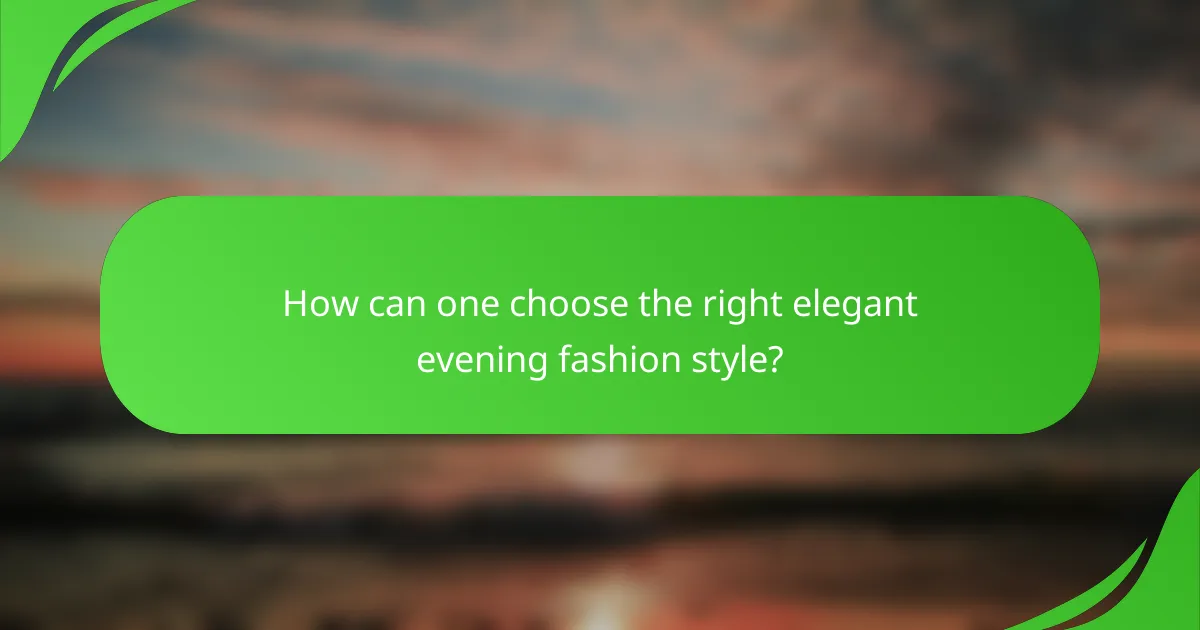
How can one choose the right elegant evening fashion style?
To choose the right elegant evening fashion style, consider the event’s dress code. Understanding whether it is formal, semi-formal, or cocktail is crucial. For formal events, opt for long gowns or tuxedos. Semi-formal attire can include cocktail dresses or tailored suits. The choice of fabric also impacts elegance; silk and satin are often preferred for their luxurious feel. Accessories should complement the outfit without overwhelming it. Choose statement pieces like elegant jewelry or a sophisticated clutch. Lastly, ensure that the fit is perfect, as well-fitted clothing enhances overall appearance.
What factors should be considered when selecting an evening outfit?
When selecting an evening outfit, consider the event’s dress code. Dress codes dictate the level of formality required. Next, evaluate the venue’s ambiance and setting. An upscale restaurant may require more formal attire than a casual gathering. Additionally, assess the weather conditions. Temperature and precipitation can influence fabric choices and layering. Personal comfort is also crucial; ensure the outfit allows for ease of movement. Finally, choose accessories that complement the outfit without overwhelming it. These factors collectively ensure an appropriate and stylish evening ensemble.
How do personal style and body type affect outfit selection?
Personal style and body type significantly influence outfit selection. Personal style reflects individual preferences, aesthetics, and lifestyle. Body type determines how clothing fits and flatters an individual’s shape. For example, hourglass figures may benefit from fitted dresses that accentuate curves. In contrast, rectangular body types might prefer outfits that create the illusion of curves, such as peplum tops.
Additionally, personal style can dictate color choices, patterns, and accessories. A classic style may gravitate towards timeless pieces, while a trendy style may opt for bold, contemporary designs. Research indicates that understanding body type can enhance self-confidence in outfit choices. Studies show that individuals who dress according to their body shape report higher satisfaction with their appearance.
Ultimately, aligning personal style with body type leads to more effective and flattering outfit selections.
What role does the season play in choosing evening fashion?
The season significantly influences the choice of evening fashion. Seasonal weather conditions dictate fabric selection. For instance, lighter fabrics like chiffon and silk are preferred in summer. In contrast, heavier materials like velvet and wool are suitable for winter. Seasonal colors also affect choices; pastels are popular in spring, while deep hues are favored in fall. Additionally, the length of garments can vary; shorter dresses are common in warmer months. Accessories, such as wraps or shawls, are often added in colder seasons. Overall, the season shapes the aesthetic and practicality of evening attire.
What are the common mistakes to avoid in elegant evening fashion?
Common mistakes to avoid in elegant evening fashion include choosing inappropriate attire. Wearing overly casual clothing can detract from the event’s formality. Ignoring the dress code can lead to feeling out of place. Selecting ill-fitting garments can compromise both comfort and appearance. Over-accessorizing can create a cluttered look. Neglecting to consider fabric quality can result in a less polished appearance. Failing to coordinate colors and patterns can lead to a mismatched outfit. Lastly, not paying attention to grooming can undermine an otherwise elegant ensemble.
How can one ensure their outfit aligns with the event’s formality?
To ensure an outfit aligns with an event’s formality, one must first understand the dress code specified. Common dress codes include black tie, formal, semi-formal, and casual. Each code dictates specific attire, such as tuxedos for black tie or cocktail dresses for semi-formal events. Research the event’s invitation or consult the host for clarity. Additionally, consider the venue and time of day, as these factors influence formality. Fabrics also play a role; silk and satin are typically more formal than cotton or linen. Accessories should complement the outfit and adhere to the formality level. For example, formal events may require elegant jewelry, while casual settings allow for simpler pieces. Following these guidelines helps ensure the outfit is appropriate for the occasion.
What are the pitfalls of over-accessorizing an evening look?
Over-accessorizing an evening look can lead to a cluttered appearance. This detracts from the elegance and sophistication intended for such occasions. An excessive number of accessories can also draw attention away from the outfit itself. This creates a disjointed look that lacks cohesion. Additionally, over-accessorizing can lead to discomfort, as multiple pieces may become cumbersome. It can also clash with the dress code, making the wearer seem out of place. A balanced accessory choice enhances the overall style without overwhelming it. Fashion experts recommend limiting accessories to maintain a polished and refined aesthetic.
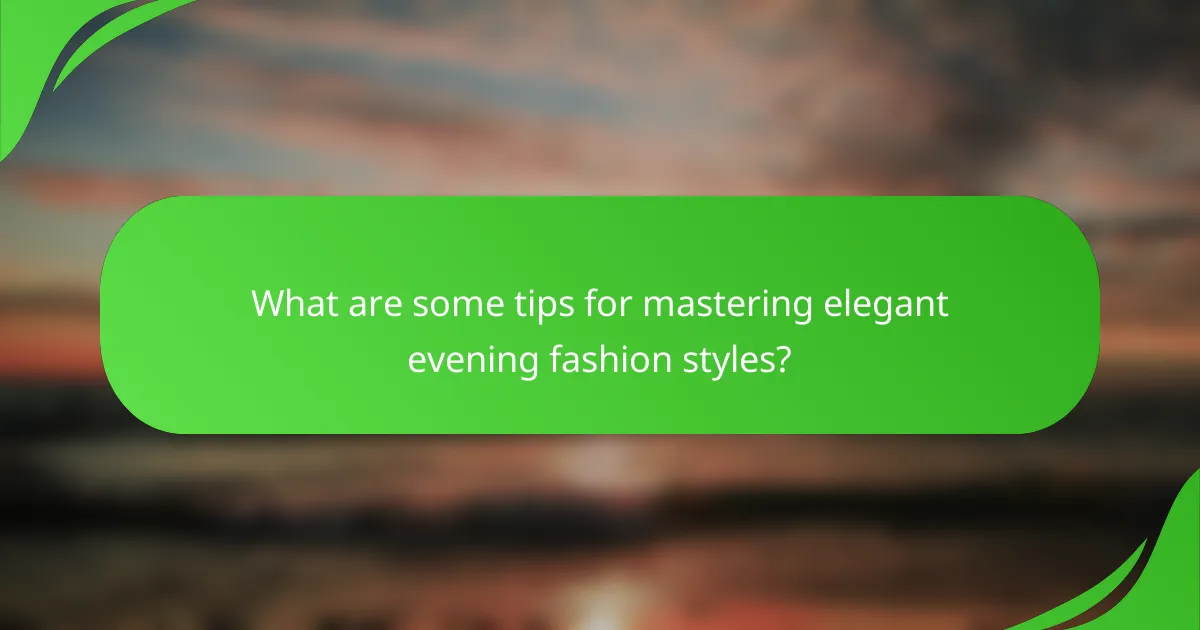
What are some tips for mastering elegant evening fashion styles?
To master elegant evening fashion styles, focus on choosing the right attire, accessories, and fabrics. Opt for classic silhouettes like A-line dresses or tailored suits. Select fabrics such as silk, satin, or chiffon for a luxurious feel. Pay attention to color; deep hues like navy, burgundy, or black convey sophistication. Accessories should be minimal yet impactful; consider statement earrings or a chic clutch. Ensure your footwear complements your outfit; elegant heels or polished dress shoes are ideal. Tailoring is crucial; well-fitted clothing enhances elegance. Lastly, confidence is key; wear your outfit with poise to truly embody elegance.
How can one stay updated on evening fashion trends?
To stay updated on evening fashion trends, one can follow fashion blogs and websites. These platforms often provide timely insights into the latest styles. Social media is another effective tool. Following fashion influencers on Instagram or TikTok can showcase current trends in real-time. Attending fashion shows is also beneficial. Events like New York Fashion Week reveal upcoming styles directly from designers. Subscribing to fashion magazines keeps readers informed about seasonal trends. Engaging in online fashion forums allows discussions with others interested in evening wear. Lastly, browsing retail websites can show trending items and collections.
What resources are available for fashion inspiration?
Fashion inspiration can be found in various resources. Popular fashion magazines like Vogue and Harper’s Bazaar showcase current trends and styles. Online platforms such as Pinterest and Instagram feature user-generated content for diverse looks. Fashion blogs often provide detailed outfit ideas and styling tips. Designer websites offer insights into seasonal collections and runway shows. Social media influencers also share their unique interpretations of fashion. Additionally, fashion shows and events present the latest styles in real-time. These resources collectively offer a wealth of inspiration for anyone interested in fashion.
How can one incorporate current trends into classic evening styles?
To incorporate current trends into classic evening styles, one can blend contemporary elements with timeless designs. For instance, adding trendy accessories like statement earrings or bold clutches can modernize a classic gown. Incorporating current color palettes, such as pastels or vibrant hues, can refresh traditional silhouettes. Layering with contemporary outerwear, like a tailored blazer or a stylish shawl, can also enhance the overall look. Utilizing modern fabrics, such as sustainable materials or innovative textures, can elevate classic evening wear. Finally, experimenting with unique footwear, such as chunky heels or embellished flats, can provide a fresh twist while maintaining elegance.
What practical advice can help in selecting and styling evening wear?
Choose evening wear that fits the dress code of the event. Understanding the occasion is crucial. For formal events, opt for long gowns or tuxedos. Semi-formal settings allow for cocktail dresses or dressy separates. Select fabrics that suit the season; silk and chiffon are ideal for warmer months, while velvet and heavier fabrics work for cooler weather. Consider the color palette; darker shades are typically more appropriate for evening events. Pay attention to fit; tailored garments enhance appearance and comfort. Accessorize wisely; statement jewelry can elevate a simple outfit. Footwear should complement the outfit and be comfortable for extended wear.
How should one approach fitting and tailoring for evening outfits?
One should approach fitting and tailoring for evening outfits with precision and attention to detail. Proper fitting ensures that the outfit complements the body shape. Tailoring should enhance the silhouette while providing comfort. Measurements must be accurate to achieve the desired fit. Consider the fabric’s drape and structure when tailoring. Evening outfits often require a more structured fit for a polished look. Pay attention to the length of sleeves and hemlines for elegance. Tailoring should also accommodate movement for comfort during events.
What are the best practices for coordinating colors and patterns?
The best practices for coordinating colors and patterns involve understanding color theory and pattern balance. Start by selecting a color palette with a dominant color and complementary shades. Use the 60-30-10 rule, where 60% of the outfit is the dominant color, 30% is a secondary color, and 10% is an accent color. When mixing patterns, ensure they share a common color to create cohesion. Vary the scale of patterns; combine large prints with smaller ones for visual interest. Limit the number of different patterns to avoid overwhelming the look. According to fashion experts, these methods enhance overall aesthetic appeal and maintain elegance in evening attire.
Elegant evening fashion styles encompass sophisticated attire designed for formal events, including long gowns, tuxedos, and cocktail dresses made from luxurious fabrics like silk and satin. Dress codes play a crucial role in determining appropriate attire, ranging from formal to casual, and influence choices in color, style, and accessories. Common fabrics used in elegant evening wear enhance aesthetics and comfort, while accessories such as statement jewelry and chic clutches complete the look. This article provides insights into selecting the right evening outfit, understanding dress codes, and mastering the elements of elegant fashion.
